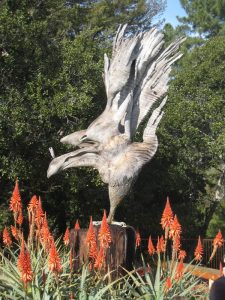
Phoenix Bird
David Jay Brown Interviews Edmund Kara, March 29, 1996
Nepenthe – a landmark restaurant in Big Sur, California – has one of Edmund Kara’s wood sculptures permanently on display near its entrance, which many people who pass through the coastal paradise are familiar with. However, if you haven’t been to Big Sur, chances are you don’t know who Edmund is. Although he is probably one of the finest sculptors alive, very few people are familiar with his work. At seventy years old he has a house overflowing with incredible museum quality sculptures, but there have been very few public showings of his work. This is because the work was born out of his passion for creating, and he has had no interest in commercial success, so he hasn’t ever sought it out.
His sculptures are life-size and larger-than-life renditions of mythological creatures, archetypal personalities, and biblical figures. “The Seven Deadly Sins”, for example, depicts a huge seven headed writhing serpent, each head brilliantly capturing a facial expression that corresponds to pride, lust, anger, gluttony, envy, avarice, and sloth. “Moses” seems to be inspired with divine revelation. The titles of his pieces are often as brilliant as the work themselves, adding enormous insight and humor to one’s appreciation of the piece. The detail is uncanny. They have a magical and haunting quality, and almost appear to be alive. The pieces shine with an extremely powerful presence, especially when seen all together in his studio. One gets the feeling that when the clock strikes midnight, and everyone is asleep, all the mythic wooden creatures spring to life.
Edmund has led a fascinating life. He traveled around the world on his bicycle in his youth. He had a successful career in fashion in both New York and Los Angeles. He was capable of pulling together interior spaces, both large and small, into truly unique environments. A costume designer with clients such as Lena Horne, Peggy Lee, Keely Smith and Maria Cole; he left the Hollywood career behind for a life devoted to sculpture.
There is a timeless quality about Edmund Kara. He seems to have stepped out of another time, or rather, he seems to have always existed. He lives on a breathtakingly beautiful mountain in Big Sur, a “suburb of Mount Olympus” he calls it, (which he shares with interesting neighbors — an architect, a poetess, cinematographer, woodworker, T.V. mogul, and surfers), in a home of his own design.
His home is closer to the ocean than his neighbors, and for some reason he reminds me of a sea captain. He has a white beard and large eyes, and a very powerful presence. He looks you directly in the eyes — with a kind of laser beam intensity — when he speaks, and is extremely dramatic and highly expressive. There is grandness to his style of communication. He has a tough exterior, but a gentle soul. This interview occurred at his home on March 29, 1996. The sound of the ocean crashing below provided a timeless ambiance as we began.

Recent Comments